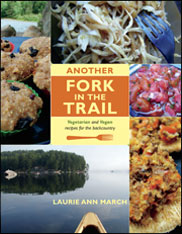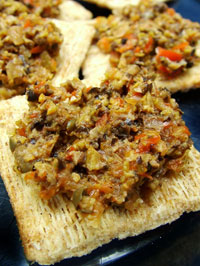
vegetarian and vegan recipes
I have finally completed the second instalment in my wilderness cookbook series. Well, let me rephrase that. I’m almost done—I just need to do one more read through of the final layouts before it hit the presses this week. I’m doing that today because it’s just easier to sneak away to a quiet spot for reading while Bryan is home for the weekend.
The book is entitled Another Fork in the Trail: Vegetarian and Vegan Recipes for the Backcountry and will be on shelves this Spring. If you like, you can pre-order at a variety of on-line retailers including Amazon.ca, Chapters.Indigo.ca, Amazon.com, and BarnesandNoble.com.
I thought that I would take a short break and post one of my favorite lunch recipes from the book. This recipe isn’t just for the backcountry; we enjoy having this for a weekend lunch at home. If you want to have it at home just skip the dehydration instructions.
mediterranean garbanzo bean salad
dehydration time: 8–12 hours
makes 2 servings
I like to think of this salad as a little trip around the Mediterranean because it combines ingredients common in Spain, Italy, Greece, Israel, and Egypt. Za’atar is a flavorful spice blend available through Middle Eastern specialty stores and online spice retailers. This salad can be served cold but is especially delicious when served warm. You can even serve it over cooked quinoa or couscous for a nice dinner.
1 1/2 tablespoons olive oil or vegetable oil
1/3 cup shallots, finely chopped
1/4 teaspoon crushed red chilies (optional)
1 teaspoon orange zest
2 tablespoons fresh orange juice
Segments of 1 large orange
1 teaspoon lemon juice
2 cups canned chickpeas (garbanzo beans), drained and rinsed
1/2 cup green olives, pitted and chopped
1/2 teaspoon za’atar spice blend
1 teaspoon black pepper, freshly ground
1/8 teaspoon kosher salt
At Home
Heat the oil in a frying pan over medium to medium-high heat. Add the shallots and sauté for a few minutes. Add the crushed red chilies, orange zest, orange juice, and orange segments. Cook for a few more minutes and then add the lemon juice, chickpeas, olives, and za’atar spice blend. Simmer for a few minutes and then remove from the heat. Stir in the pepper and salt.
Allow the mixture to cool and then measure the amount you will dry. Write this measurement on a sticky note. Spread the salad on lined dehydrator trays to dry. When the salad is dry, package it in a ziplock freezer bag along with your note.
At Camp
Rehydrate the salad by adding enough boiling water to the mix to make it equal to the measurement on your sticky note. Be sure to account for and add your dried ingredients to the rehydration container prior to adding the water. You can always add more water if you need to. Once the salad has rehydrated, reheat it if desired.
Tips
If you can’t find za’atar, then use a combination of thyme and basil, as they will pair nicely with this salad as well.
If you’d like to have this recipe for lunch, you can add cold water to the mixture at breakfast and let it rehydrate in your pack as you travel.
This is also good for dinner served on couscous or quinoa that has been cooked with a little vegetable stock or orange juice or with pitas that have been toasted, drizzled with a little olive oil, and sprinkled with a bit of the za’atar spice.
From Another Fork in the Trail by Laurie Ann March ©2010/2011

